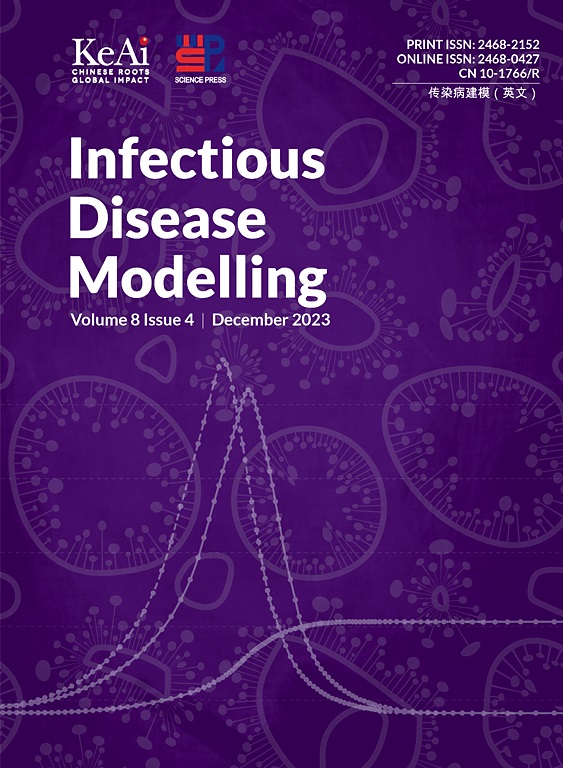用计算机工具报告血蜱和落基山斑疹热的控制情况
IF 2.5
3区 医学
Q1 Medicine
引用次数: 0
摘要
我们探索了一个“易感-感染-恢复”的隔间模型,以优先考虑和测试基于狗和蜱的干预措施对落基山斑疹热及其蜱媒血根头蜱的有效性。面对日益严重的城市RMSF流行,特别是针对边缘社区,包括全部或部分犬类扑杀、生育控制和财产限制;对狗和环境杀螨剂;针对公共卫生工作者和高危居民的教育和意识项目是不可持续的资源密集型项目,在管理很难控制的蜱虫方面可能缺乏效力。我们的模型使我们能够制定干预措施战略,并以与下加利福尼亚州恩塞纳达流行病相关的参数为例,制定针对RMSF的优化运动。结合对狗使用杀螨剂和环境优化的成功,通过长达10年没有新的犬类病例(人类病例的代表)以及减少蜱虫负担来衡量。当运动在冬季或春季开始并达到至少60%的覆盖率时,成功更大。这种组合比单独使用狗或环境杀螨剂、扑杀狗(只成功清除了100%的狗)和绝育运动(没有减少蜱虫负担)要成功得多。然而,作为杀螨运动的辅助手段,室外狗的绝育有助于稳定犬类数量并鼓励群体免疫。虽然Ensenada是参数化的,但该模型可以很容易地用于其他社区,在那里可以获得犬蜱负担和蜱生活史特征的数据,以便在公共卫生资源有限的情况下定制干预细节,如最佳时间、覆盖范围和重新应用频率。本文章由计算机程序翻译,如有差异,请以英文原文为准。
Control of Rhipicephalus sanguineus ticks and Rocky Mountain spotted fever informed by an in silico tool
We explored a compartment “susceptible-infected-recovered” model to prioritize and test the effectiveness of dog- and tick-based interventions against Rocky Mountain spotted fever and its tick vector Rhipicephalus sanguineus s.l. In the face of increasingly urban epidemics of RMSF with high case fatality, particularly targeting marginalized communities, wrap-around campaigns (comprising all or some of canine culling, fertility control, and restraint to property; on-dog and environmental acaricide; and education and awareness programs for public health workers and at-risk residents) are unsustainably resource-intensive and may lack efficacy in managing the very hard to control tick. Our model allows us to strategize interventions and develop an optimized campaign against RMSF, using parameters associated with the epidemic in Ensenada, Baja California as an example. Combining usage of acaricides on dogs and the environment optimized success as measured by up to 10 years of no new canine cases, a proxy for human cases, as well as reduced tick burden. Success was greater when the campaign was begun in winter or spring and achieved at least 60 % coverage. This combination was considerably more successful than either dog or environmental acaricide alone, culling of dogs which was only successful with 100 % of dogs removed, and spay/neuter campaigns which did not reduce tick burdens. However, spay/neuter of outside dogs as an adjunct to the acaricide campaign helped stabilize the canine population and encouraged herd immunity. Although parameterized for Ensenada, the model can easily be run for other communities where data on canine tick burden and tick life history traits are available, in order to tailor intervention details such as optimal timing, coverage, and re-application frequency even when public health resources are limited.
求助全文
通过发布文献求助,成功后即可免费获取论文全文。
去求助
来源期刊

Infectious Disease Modelling
Mathematics-Applied Mathematics
CiteScore
17.00
自引率
3.40%
发文量
73
审稿时长
17 weeks
期刊介绍:
Infectious Disease Modelling is an open access journal that undergoes peer-review. Its main objective is to facilitate research that combines mathematical modelling, retrieval and analysis of infection disease data, and public health decision support. The journal actively encourages original research that improves this interface, as well as review articles that highlight innovative methodologies relevant to data collection, informatics, and policy making in the field of public health.
 求助内容:
求助内容: 应助结果提醒方式:
应助结果提醒方式:


